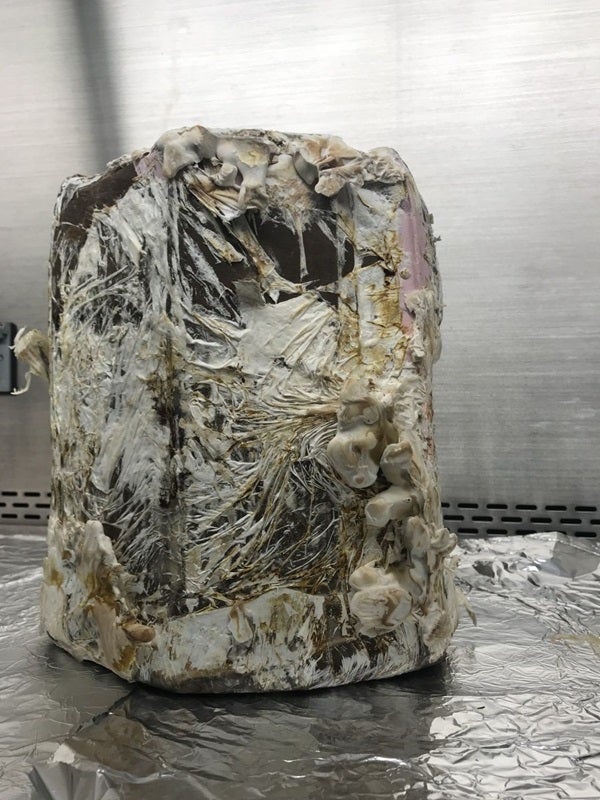Growing structures made of mushrooms on the Moon might seem like something straight out of a Ray Bradbury story. But it turns out to be more practical, and is happening more promptly, than you might think.
Just two years from now, a project is slated to head Moonward to test whether mycotecture — the use of mushrooms and other fungal substances for architectural purposes — could play a pivotal role in helping humanity construct the first off-planet habitats on the Moon and beyond.
The brainchild of architect Chris Maurer and his team at redhouse, working in collaboration with NASA and the MIT Center for Bits and Atoms, this potentially game-changing building technique is surprisingly straightforward.
Recently, I spoke with Maurer via Zoom, and he walked me through the process.
A recipe for mushroom building blocks
From the redhouse lab in Cleveland, Maurer began by showing me a metal tube from which he extracted a chain of vibrantly green algae bundles. These are chaetomorpha, and they are destined to become mushroom food.
Once added into an inflatable mold with water, the chaetomorpha grow into their intended form before scientists add mycelium — the thready, root-like structure from which mushrooms grow. The mycelium eats the chaetomorpha, filling up the mold as it develops and expands into its desired structural shape.
At this point, pressurized air is used to compact the shaped mycelium into a dense, semi-rigid material. It is then cooked to both solidify the fungal building block and kill off any living organisms that could otherwise contaminate extraterrestrial environments.
The resulting myco-material has a foamy texture something like stucco.
Building Moon bases with mushrooms
The concept of building structures with compressed fungus has progressed well beyond the theoretical stage, as Maurer’s team is already using a similar process to “grow” and build with myco-materials here on Earth. They’ve also already created test models for off-planet versions in the lab.
Via Zoom, Maurer showcased a roughly 12-foot-wide, pale-sulfur-colored dome grown with the myco-composite. He then brought the camera to a desk littered with smaller models of inflatable molds similar to those that are planned to be sent to the Moon for testing.
Maurer next lifted what appeared to be a tiny inflatable mattress — something like what you might take on a camping trip. He then used a small rubber bulb to pump it into an approximately one-foot-square dome tent with a surface resembling a patchwork quilt made of plastic.
Such quilted segments would be filled with chaetomorpha and mycelium before being compressed and cooked into building blocks. And thanks to their plastic mold exteriors, these blocks would allow for the construction of airtight structures.
The plastic-enhanced myco-material “is pretty strong,” Maurer said, “but it’s nowhere near strong enough to build on Earth. Of course, Earth has more gravity, so that’s why you need stronger materials here. When we’re going to the Moon and Mars, the big thing we have to worry about is the outward pressure of the interior environment that’s going to have air while the outside’s not going to have air.”
In other words, instead of creating fungus-based structures that won’t collapse inward due to gravity, designers must ensure the buildings won’t collapse outward due to positive internal pressure.
The benefits of building with mushrooms
While the myco-material has yet to be tested in space, thanks to a combination of the myco-material itself and the plastic mold encompassing it, researchers are confident that it can achieve the structural integrity they need — while also being fire resistant and insulating. Furthermore, a mycotectural approach to construction in space solves another looming extraterrestrial building problem: the matter of cost.
One of the biggest obstacles in constructing buildings off-planet is the sheer expense of transporting building materials. Presently, launching something to the Moon still comes with an astronomical price tag. Therefore, sending extremely compact, lightweight materials — like algae starts, mushroom spores, and thin plastic molds — that will then “grow” into significantly larger structures has tremendous appeal.
That low cost is partly why, after a recent review, the National Infrastructure Advisory Council signed off on the project, with one NASA official declaring that it represents the greatest scientific synergy he’s seen since the Apollo missions, according to a chuckling Maurer.
“I’m pretty proud of it,” he admitted.
Maurer’s myco-models are tentatively slated to reach the Moon in 2025, as per NASA’s Commercial Lunar Payload Services (CLPS) schedule.










